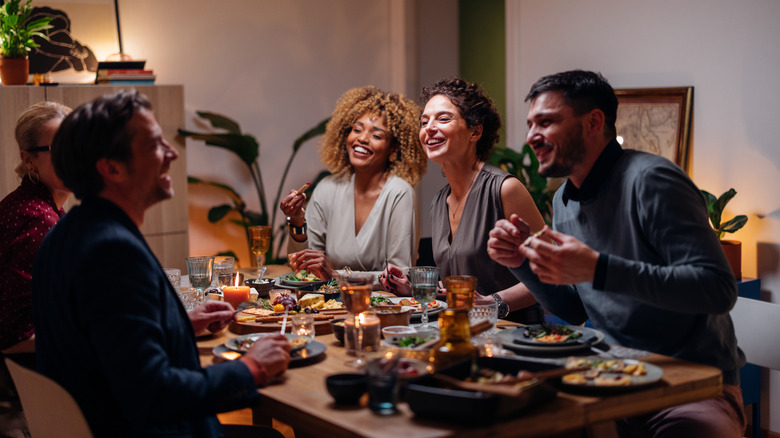Hosting Etiquette Tips For Left-Handed Guests
As the old adage says, "You can't choose your family, but you can choose your friends." And even then, we can't choose whether they're right- or left-handed. If you have family and friends who are among the 10% of the population that's left-handed, surprise them the next time you're hosting with a special dining set-up just for them. It's already hard enough on left-handers living in a right-handed world. And it requires just a minimal effort on your part to make sure those lefties feel seen at your next sit-down dinner.
We're not suggesting you add a hand dominance poll to your next Evite to publicly out those lefties, but if you already happen to know, then why not set them up for social success? No one wants to tangle with the person next to them while eating, but with a thoughtful seating arrangement, your guests can all eat in harmony without anyone clashing elbows. If your hosting style is to mix up your guests around the table anyway, then all the better to add this quick fix to your list of holiday entertaining tips.
Give left-handed dining guests some elbow room
A standard place setting calls for forks on the left of the plate and knife and spoon on the right, which is perfect for right-handed people. On the other hand (heh heh), lefties will most often place their knife in their left hand to cut while holding their fork in their right hand. Then, they will likely switch their fork to their left hand to eat. This is called American style dining and it differs from European style, where the fork always remains in the left hand, regardless of your dominant hand.
American style dining means that a lot of action is happening on a person's dominant side. When a left-hander is seated to the right of a right-hander who is doing these same actions in reverse, you're about to have an elbow fight. By simply seating your left-handed friends on an end seat or on a left corner, you can solve this battle before it begins. If you're doing the math, that makes at least four seats at a typical dining table that are suitable for lefties. Statistically, you probably don't even dine with that many left-handers.
If you're not a fan of splitting up couples or if you know certain personalities will vibe in a different seating arrangement, you can simply leave things as normal and let the lefty take matters into their own hands. We certainly don't want this minority to feel even more marginalized. Fortunately, many of them have learned to be at least partially ambidextrous anyway out of necessity. Now, if we could only figure out a seating arrangement to solve all of our other family dramas and make get-togethers and parties less stressful.

